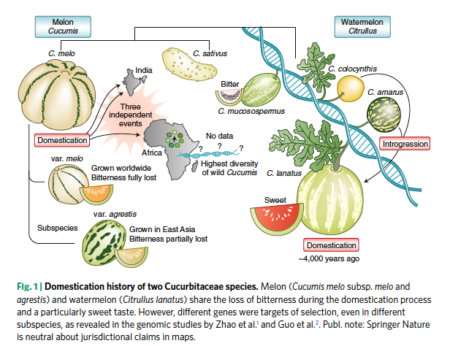- Breeding chillis for mechanization.
- Long, but very engaging, video on zooarchaeology in general and goat bones in particular.
- Delving into the origins of the sweetpotato at CIP.
- Cultivating Leptospermum scoparium for honey.
- Saving languages.
- Jasmonic acid is bad for sorghum yields.
The sweetest things
There’s been a lot of action on the cucurbit domestication front lately. Hot on the heels of a comprehensive Tansley review of all the crops in the family in New Phytologist 1 now come two papers out of the Chinese Academy of Agricultural Sciences focusing on the melon and watermelon:
- Zhao, G., Lian, Q., Zhang, Z. et al. A comprehensive genome variation map of melon identifies multiple domestication events and loci influencing agronomic traits. Nat Genet 51, 1607–1615 (2019) doi:10.1038/s41588-019-0522-8.
- Guo, S., Zhao, S., Sun, H. et al. Resequencing of 414 cultivated and wild watermelon accessions identifies selection for fruit quality traits. Nat Genet 51, 1616–1623 (2019) doi:10.1038/s41588-019-0518-4.
There are press releases on each of these, of course. But the more interesting take is provided by some IPK researchers 2, who mash up the two studies. 3 And provide a nice graphic to summarize the whole thing.

The bottom line(s)? The two different subspecies of melon acquired sweet flesh through different mutations, independently but probably both in India; there was a third domestication event in Africa, but the authors had too little material at hand to say much about this. Melon and watermelon lost their bitterness through convergent evolution, and the latter has benefitted from introgression from two wild relatives, one of which was separately domesticated for its seeds.
Nibbles: Root & tuber breeding, Potato fun, Melon domestication, Maize conservation, Millet diversification, Business as usual
- A backyard breeder evaluates USDA’s potato accessions. Among other things.
- The Onion roasts potatoes.
- How melons got sweet.
- Mexican Senate considers in situ/on farm conservation areas for maize.
- Millets for climate change resilience in India.
- Business for biodiversity. Yeah, right.
Brainfood: Ecosystem services, Farmer Variety protection, Pineapple genome, Almond genome, Date palm genome, Sesame diversity, Frangmentation double, Alternative beans, AI & farmers, De-domestication
- Global modeling of nature’s contributions to people. Declining where the need is greatest. And that’s not even taking CWR into account.
- Farmer’s Varieties in India – Factors affecting their preferential prevalence and the current status of their legal protection. Open-pollinated crops are missing out.
- The bracteatus pineapple genome and domestication of clonally propagated crops. Domestication and early improvement as the result of a single clonal propagation event.
- Transposons played a major role in the diversification between the closely related almond and peach genomes: Results from the almond genome sequence. Including the sweet kernel phenotype.
- Genome-wide association mapping of date palm fruit traits. Fruit color and sugar composition changed in parallel.
- Genetic diversity and population structure of the Mediterranean sesame core collection with use of genome-wide SNPs developed by double digest RAD-Seq. Three genetic groups, but not geographically based.
- Ongoing accumulation of plant diversity through habitat connectivity in an 18-year experiment. You need those corridors.
- Meta‐analysis of the differential effects of habitat fragmentation and degradation on plant genetic diversity. You really do.
- In search of alternative proteins: unlocking the potential of underutilized tropical legumes. Beyond soybeans. I always liked Bambara groundnut.
- A scalable scheme to implement data-driven agriculture for small-scale farmers. Fancy maths put to some good use in Colombia. But what if it tells you to grow more coca?
- The evolution of crops that do not need us anymore. They’re called weeds.
Nibbles: How-to trifecta, Indigenous maps, ITPGRFA, SeedLinked, Tequila
- The Center for Plant Conservation has Best Plant Conservation Practices to Support Species Survival in the Wild. With online forum goodness.
- A little bit down-market, there’s What Are Seed Banks: A Complete Guide.
- How Do We Preserve the Vanishing Foods of the Earth? Good question, and nice article, but there’s surely more to the answer than what it says.
- Like indigenous people.
- And the Plant Treaty. Here’s two provocative briefing papers on that from the African Centre for Biodiversity in the run-up to the Governing Body meeting in November.
- Oh, and breeding. Even crowd-sourced breeding.
- Let the tequila industry show you what to do, in fact.